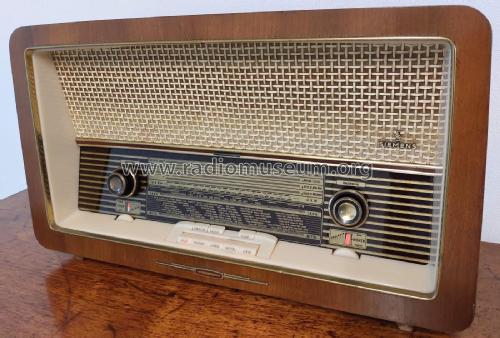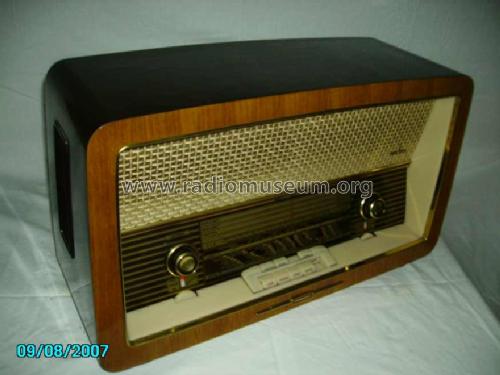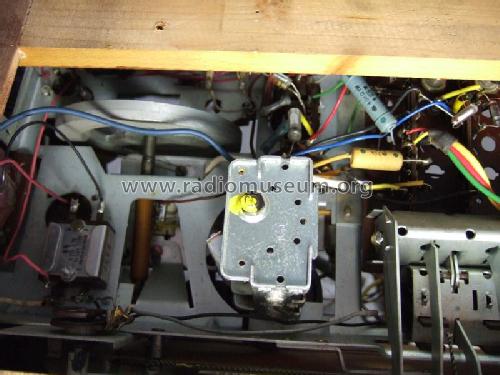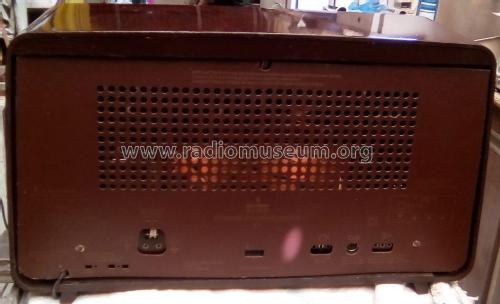- País
- Alemania
- Fabricante / Marca
- Siemens (& Halske, -Schuckert Werke SSW, Electrogeräte); Berlin, München
- Año
- 1959/1960
- Categoría
- Radio - o Sintonizador pasado WW2
- Radiomuseum.org ID
- 22167
Haga clic en la miniatura esquemática para solicitarlo como documento gratuito.
- Numero de valvulas
- 6
- Principio principal
- Superheterodino en general; ZF/IF 460/10700 kHz
- Número de circuitos sintonía
- 6 Circuíto(s) AM 10 Circuíto(s) FM
- Gama de ondas
- OM, OL y FM
- Tensión de funcionamiento
- Red: Corriente alterna (CA, Inglés = AC) / 110; 127; 220 Volt
- Altavoz
- 3 Altavoces
- Potencia de salida
- 5 W (unknown quality)
- Material
- Madera
- de Radiomuseum.org
- Modelo: Standardsuper E9 - Siemens & Halske, -Schuckert
- Forma
- Sobremesa de botonera.
- Ancho, altura, profundidad
- 600 x 350 x 210 mm / 23.6 x 13.8 x 8.3 inch
- Anotaciones
- abschaltbare Ferritantenne.
- Peso neto
- 8 kg / 17 lb 9.9 oz (17.621 lb)
- Precio durante el primer año
- 289.00 DM
- Ext. procedencia de los datos
- Erb
- Procedencia de los datos
- HdB d.Rdf-& Ferns-GrH 1959/60
- Otros modelos
-
Donde encontrará 2528 modelos, 2135 con imágenes y 1334 con esquemas.
Ir al listado general de Siemens (& Halske, -Schuckert Werke SSW, Electrogeräte); Berlin, München
Colecciones
El modelo Standardsuper es parte de las colecciones de los siguientes miembros.
Contribuciones en el Foro acerca de este modelo: Siemens & Halske, -: Standardsuper E9
Hilos: 2 | Mensajes: 34
The FM or UKW band is generating a big noise and the volume goes up and down as I keep dialing...In other words the UKW is not tuning to any stations but very noisy... Any idea how to fix it.. I am new to this world of old tube radio and not sure how to find the bad capacitor that I can change to fix the problem. The long and medium waves are working fine.
David Erali, 26.Aug.18
The FM dipole is only going to pickup "E" field on MW & LW. I have read people suggesting that the FM ant switch is to "improve" AM reception. Well it does.
But not by picking up more signal from the Radio station. The Ferrite Rod is the main aerial for AM bands. The E field is very much higher at Lower frequency when it's a very short aerial in the "Near Field", this means the FM dipole will pick up very local interfence from SMPSU very well but the AM radio station will be poor reception on it.
Thus by rotation of the Ferrite Rod and trying both orientations of the dipole (to reverse phase) the local interference can be greatly reduced with perhaps just a small reduction in the desired signal. The local SMPSU Interference is greatly reduced. Presumably in 1959 the local interference would have been TV line Drive harmonics of 15.625KHz in Germany and any local motors like a fridge compressor.
Michael Watterson, 11.Jan.12





























